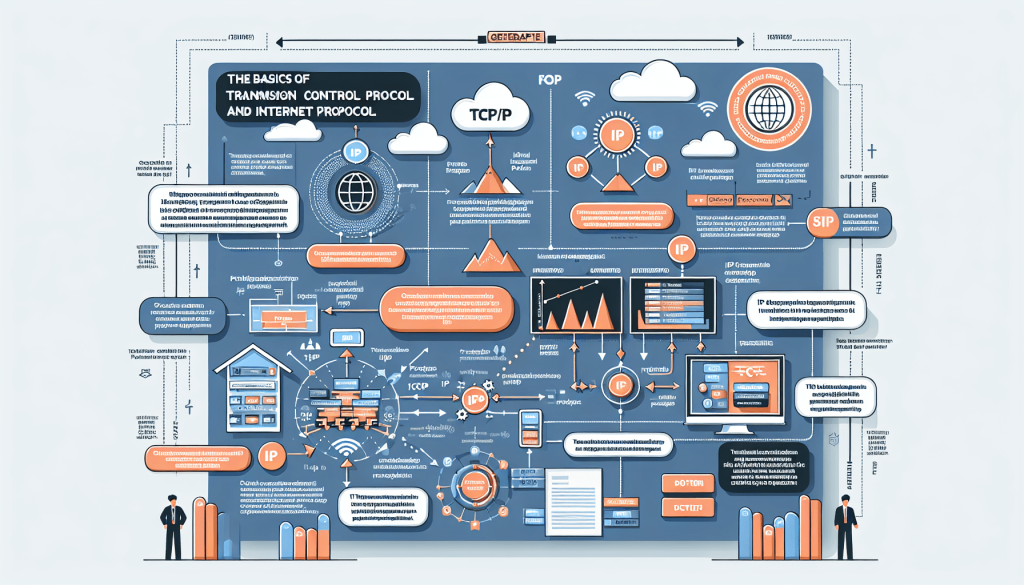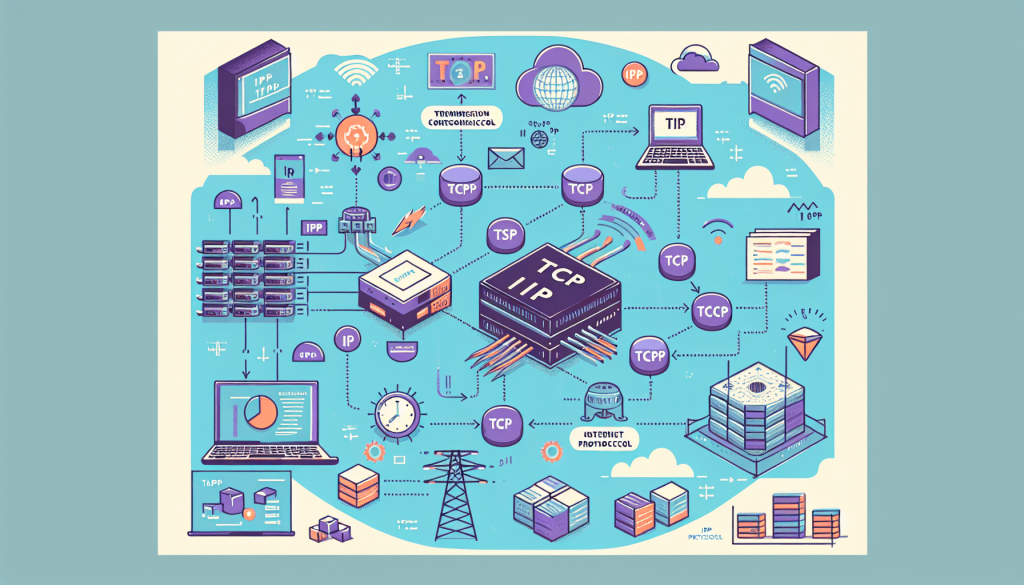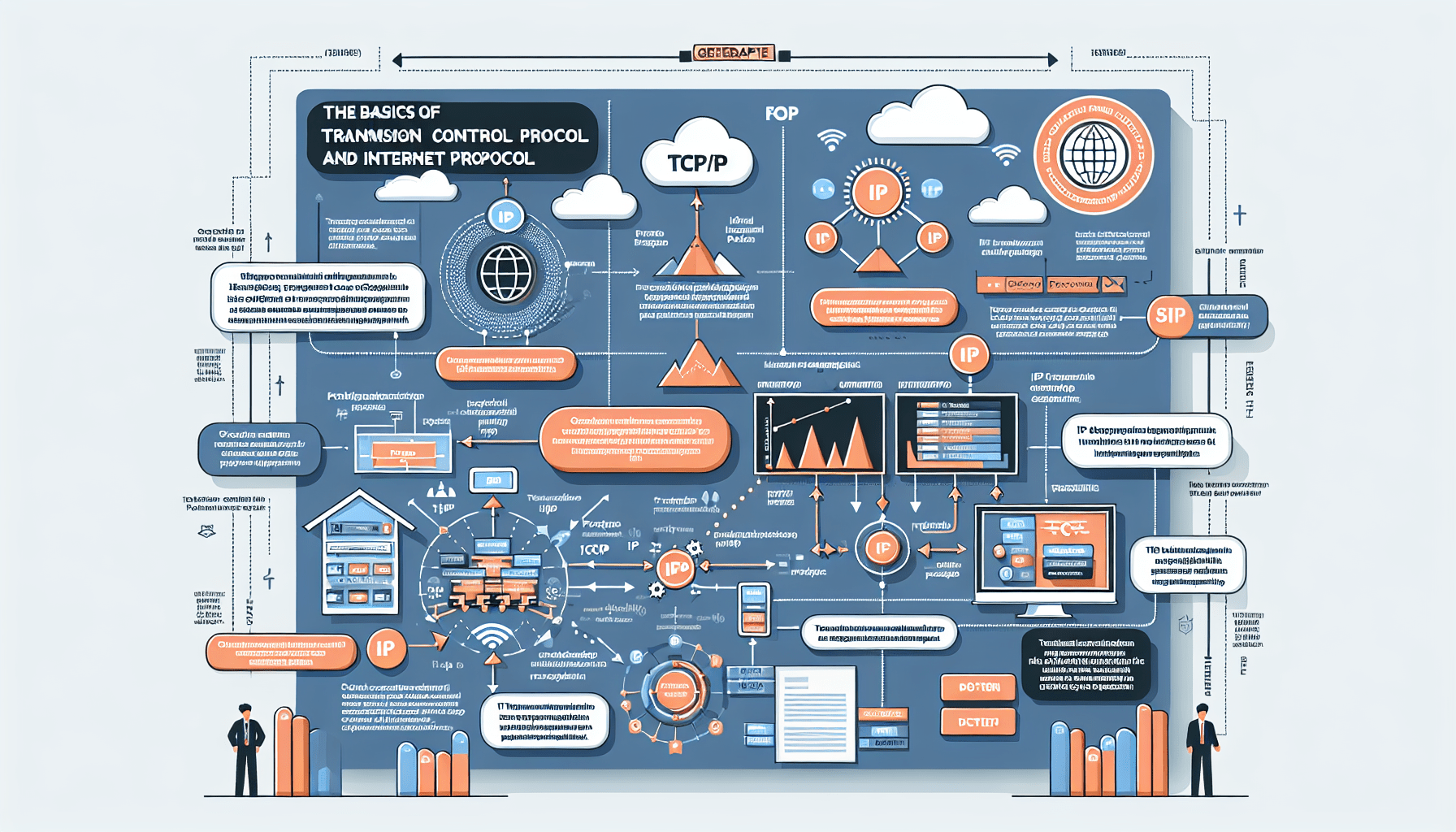In this article, we present a comprehensive overview of the fundamental concepts behind TCP/IP, a widely used protocol suite that facilitates communication between devices connected to the internet. We delve into the core components and functionalities of TCP/IP, exploring its layered structure and the role each layer plays in data transmission. Additionally, we shed light on common TCP/IP errors, providing insights into their causes and potential troubleshooting techniques. By grasping the basics of TCP/IP, readers will gain a solid foundation and be better equipped to navigate the intricacies of network communication.

What is TCP/IP
TCP/IP (Transmission Control Protocol/Internet Protocol) is a set of communication protocols that allow computers and devices to connect and communicate with each other over a network. It is the foundation of the internet, enabling data transmission between hosts in a reliable and efficient manner. TCP/IP provides a standardized framework for data packet routing, addressing, and error detection, ensuring successful transmission of data across different networks and systems.
Definition of TCP/IP
TCP/IP is a suite of protocols that outlines the rules and procedures for transmitting data packets over a network. It comprises two main protocols: TCP, which provides reliable and ordered delivery of data, and IP, which handles the addressing and routing of the packets. TCP/IP serves as a universal language that computers can use to communicate with each other, regardless of the underlying hardware or software.
Function of TCP/IP
The primary function of TCP/IP is to facilitate the communication and exchange of data over a network. It enables devices to establish connections, transfer data, and ensure the integrity and reliability of the transmitted information. TCP/IP achieves this by breaking the data into small packets, assigning them unique addresses, and sending them across the network. The protocols within TCP/IP work together to ensure the successful delivery of these packets, managing error detection, packet sequencing, and retransmission if necessary.
TCP/IP Layers
TCP/IP is structured in a layered model, with each layer handling specific tasks and functionalities. This layered approach allows for modular design, ease of implementation, and flexibility in adapting to various network infrastructures.
Layered Model Overview
The TCP/IP layered model consists of four main layers: the Application Layer, Transport Layer, Internet Layer, and Link Layer. Each layer has its own distinct responsibilities and works together to ensure seamless communication between hosts.
Application Layer
The Application Layer is the topmost layer in the TCP/IP model and is responsible for handling application-specific protocols and services. It includes protocols such as HTTP, FTP, SMTP, and DNS, which enable functions such as web browsing, file transfer, email communication, and domain name resolution.
Transport Layer
The Transport Layer ensures reliable and efficient data transfer between devices. It uses two main protocols: Transmission Control Protocol (TCP) and User Datagram Protocol (UDP). TCP provides reliable and connection-oriented communication, ensuring that data arrives intact and in order. UDP, on the other hand, offers a connectionless and unreliable means of communication, suitable for applications where speed and efficiency are prioritized over reliability.
Internet Layer
The Internet Layer, also known as the Network Layer, handles the addressing, routing, and fragmentation of packets across different networks. It uses the Internet Protocol (IP) to assign unique IP addresses to devices, allowing them to be identified and located on the network. The Internet Layer also determines the best route for data packets to travel from the source to the destination, taking into account factors such as network congestion and connectivity.
Link Layer
The Link Layer, also referred to as the Network Interface Layer, deals with the physical transmission of data over the network media. It encompasses protocols that define how data is encapsulated and transmitted between devices, such as Ethernet. The Link Layer ensures that data is properly formatted and transmitted in a format that the physical network media can understand.
TCP/IP Protocols
TCP/IP relies on various protocols to provide specific functionalities and services throughout the network communication process.
Overview of TCP and UDP
TCP (Transmission Control Protocol) and UDP (User Datagram Protocol) are the two main transport layer protocols in TCP/IP. While they both facilitate the transportation of data packets, they differ in terms of reliability, connection-orientedness, and overhead.
TCP Features and Functions
TCP provides reliable and ordered delivery of data packets between devices. It establishes a connection between the sender and the receiver, ensuring that data is delivered without errors, in sequence, and without loss. TCP achieves this through features such as error detection and correction, flow control, congestion control, and packet acknowledgment.
UDP Features and Functions
UDP, unlike TCP, is a connectionless and unreliable transport layer protocol. It is often used for applications that require fast and efficient transmission of data, such as real-time streaming and gaming. UDP does not provide the same level of reliability and error handling as TCP but offers lower latency and overhead. It is suitable for situations where occasional data loss does not significantly impact the overall performance.

IP Addressing
IP addressing is a fundamental aspect of TCP/IP and plays a crucial role in identifying and locating devices on a network.
Definition of IP Address
An IP address is a unique numerical identifier assigned to network devices, such as computers, smartphones, and servers, to enable communication and data transmission. It consists of a series of numbers separated by periods, with each number representing a specific network or host identifier.
IPv4 vs IPv6
There are two versions of IP addressing: IPv4 and IPv6. IPv4 (Internet Protocol version 4) uses a 32-bit address format, allowing for approximately 4.3 billion unique addresses. However, with the increasing number of devices connected to the internet, the availability of IPv4 addresses is becoming scarce. IPv6 (Internet Protocol version 6) was introduced to address this issue, using a 128-bit address format that can accommodate an astronomical number of unique addresses.
IP Address Classes
IPv4 addresses are divided into different classes based on their network and host portions. The classes are denoted by the first octet of the IP address and determine the number of networks and hosts that can be supported. The classes include Class A, Class B, Class C, Class D (reserved for multicast), and Class E (reserved for experimental use).
Private vs Public IP Addresses
Private IP addresses are used within a private network and are not accessible from the internet. They are reserved for internal use and can be reused across different private networks. Public IP addresses, on the other hand, are globally unique and can be accessed over the internet. They allow devices to communicate with each other across different networks and are assigned by Internet Service Providers (ISPs).
Subnetting
Subnetting is a technique used to divide a large network into smaller subnetworks, known as subnets. It provides several benefits, including efficient utilization of IP addresses, improved network performance, and enhanced security.
Understanding Subnet Masks
A subnet mask is a 32-bit value used in conjunction with an IP address to determine the network and host portions of the address. It consists of a continuous series of ones followed by a continuous series of zeros, with the number of ones indicating the network portion. By applying the subnet mask to an IP address, the network can be identified and used for determining routing and addressing.
Subnetting and CIDR Notation
CIDR (Classless Inter-Domain Routing) notation is a method used to represent IP addresses and subnet masks in a more concise and flexible manner. It allows for finer control over the allocation of IP addresses and simplifies the routing process. CIDR notation uses a forward slash (/) followed by the number of ones in the subnet mask, indicating the network prefix.
Routing
Routing is the process of determining the best path for data packets to travel from the source to the destination across an interconnected network.
Definition of Routing
Routing involves analyzing network topology, traffic conditions, and various routing protocols to determine the optimal path for data packets. It ensures that packets are delivered efficiently while considering factors such as network congestion, link availability, and latency.
How Routers Work
Routers are network devices responsible for forwarding data packets between networks. They examine the destination IP address in each packet, consult their routing tables, and determine the next hop or interface for the packet to proceed. Routers make decisions based on the best path, as determined by routing protocols and metrics.
Routing Protocols
Routing protocols are a set of rules and algorithms that routers use to exchange information and make informed routing decisions. These protocols include Routing Information Protocol (RIP), Open Shortest Path First (OSPF), and Border Gateway Protocol (BGP). Each protocol has its own characteristics, such as the speed of convergence, scalability, and support for different network topologies.
Routing Tables
Routing tables are crucial components of routers as they contain information about available networks, associated next hops, and various metrics. Routers consult their routing tables during the routing process to determine the best path for forwarding packets. The tables are updated dynamically through the exchange of routing updates with neighboring routers.
TCP/IP Ports
TCP/IP ports enable end-to-end communication between applications and services running on different devices within a network.
Overview of Ports
Ports are virtual communication channels that allow multiple applications to utilize network services simultaneously. They enable devices to distinguish between different types of data and direct it to the appropriate application or service.
Well-Known Ports
Well-known ports range from 0 to 1023 and are reserved for specific protocols or services. Some examples of well-known ports include Port 80 for HTTP, Port 21 for FTP, and Port 53 for DNS. These ports are standardized across different operating systems and allow for seamless communication between applications.
Registered Ports
Registered ports fall within the range of 1024 to 49151 and are assigned to specific services or applications by the Internet Assigned Numbers Authority (IANA). These ports offer flexibility for organizations to use them for their own applications while avoiding conflicts with well-known ports.
Dynamic/Private Ports
Dynamic/Private ports range from 49152 to 65535 and are used for temporary and short-lived connections. These ports are typically assigned dynamically by the operating system to ensure unique port numbers for each session.
Domain Name System (DNS)
The Domain Name System (DNS) is a critical component of TCP/IP that enables the translation of human-readable domain names into IP addresses.
Introduction to DNS
DNS is a distributed hierarchical naming system that allows devices to access internet resources using domain names. It serves as a directory service by translating user-friendly domain names, such as www.example.com, into IP addresses that routers and computers can understand.
DNS Resolution Process
The DNS resolution process involves multiple hierarchical levels of DNS servers working together to find the corresponding IP address for a given domain name. When a user enters a domain name in their web browser, the DNS resolver locates the IP address by querying authoritative DNS servers, starting from top-level domains (TLDs) and working down to authoritative name servers.
DNS Records
DNS records contain information associated with domain names and their corresponding IP addresses. Different types of DNS records serve various purposes, such as A records for mapping domain names to IPv4 addresses, AAAA records for IPv6 addresses, MX records for email servers, and CNAME records for aliasing one domain to another.
DNS Servers
DNS servers are responsible for storing DNS records and providing responses to DNS queries. They are distributed globally and organized in a hierarchical structure, with authoritative DNS servers at the top, followed by recursive DNS servers and local DNS resolvers. These servers work collaboratively to resolve domain name queries and facilitate the translation from domain names to IP addresses.
Transmission Control Protocol (TCP)
TCP is a core protocol within the TCP/IP suite that provides reliable, connection-oriented communication between devices.
TCP Overview
TCP operates at the transport layer and is responsible for ensuring that data is delivered accurately, in order, and without loss. It achieves reliability through features such as acknowledgments, sequence numbers, and flow control. TCP establishes a connection between a sender and receiver, allowing for the exchange of data packets in a reliable manner.
TCP Handshake Process
The TCP handshake process is the initial step to establish a connection between two devices. It involves a three-way communication between the sender and receiver, where each side acknowledges the other’s presence and readiness for data transmission. The handshake ensures that both parties are prepared for reliable communication and sets the initial sequence numbers and window sizes.
TCP Connection Termination
TCP connections are terminated through a process known as a graceful connection termination or TCP connection teardown. This process allows both sides of the connection to exchange any remaining data and ensures that the connection is closed in an orderly manner. TCP uses a four-way handshake to initiate the termination process, allowing for the orderly release of resources and ensuring data integrity.
User Datagram Protocol (UDP)
UDP is a transport layer protocol in the TCP/IP suite that provides connectionless, unreliable communication.
UDP Overview
UDP operates at the transport layer and offers a lightweight and low-overhead alternative to TCP. It provides a connectionless service, meaning that it does not establish a dedicated connection between the sender and receiver. UDP is often used in applications that prioritized speed and efficiency over reliability, such as real-time streaming, VoIP, online gaming, and DNS.
UDP Characteristics
Unlike TCP, UDP does not provide guaranteed delivery, ordering, or error checking of data packets. It is a best-effort protocol that focuses on speed and efficiency. UDP is ideal for situations where occasional data loss is acceptable, as it avoids the overhead and delays associated with TCP’s reliability mechanisms.
Applications of UDP
UDP is widely used in various applications and services that demand fast and lightweight communication. Real-time streaming applications, such as online video streaming and voice over IP (VoIP) services, rely on UDP to minimize delays and latency. Additionally, DNS queries, simple network management protocol (SNMP), and certain online games utilize UDP to prioritize speed and minimize overhead.
